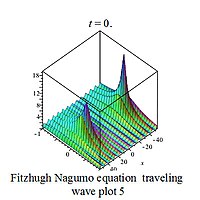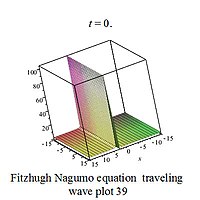菲茨休-南云方程
(重定向自菲茨休 - 南云方程)


菲茨休-南云方程(Fitzhugh-Nagumo equation)是一个非线性偏微分方程,最早由理查德·菲茨休(Richard FitzHugh)于1961年提出[1],描述了在高于阈值的常电流刺激下神经元动作电位的周期性振荡[2]。当时菲茨休将其称为“朋霍费尔-范德波尔模型(Bonhoeffer-van der Pol model)”。次年,南云仁一等人也提出了一个与该方程等效的电路[3]。该方程为霍奇金-赫胥黎模型的二维情形[4];后者因揭示了枪乌贼巨大轴突中动作电位的产生和传导机制而分享了1963年的诺贝尔生理学或医学奖。
方程[编辑]
用于描述枪乌贼巨大轴突中动作电位的菲茨休-南云方程如下[4]:
其中,为膜电位,为回复变量,为刺激电流的强度。该方程的一般形式可写作:
其中为三次多项式;a,b,c为常数。
行波解[编辑]

菲茨休 - 南云方程的解析解如下:
利用Maple软件包TWSolution可得以下行波解[6][注 1]:
相关条目[编辑]
注释[编辑]
参考文献[编辑]
- ^ FitzHugh, Richard. Impulses and Physiological States in Theoretical Models of Nerve Membrane. Biophysical Journal. 1961-07, 1 (6): 445–466. doi:10.1016/S0006-3495(61)86902-6.
- ^ Griffiths, Graham. Traveling Wave Analysis of Partial Differential Equations : Numerical and Analytical Methods with Matlab and Maple.. Burlington: Elsevier Science. : 147-172. ISBN 9780123846532.
- ^ Nagumo, J.; Arimoto, S.; Yoshizawa, S. An Active Pulse Transmission Line Simulating Nerve Axon. Proceedings of the IRE. 1962-10, 50 (10): 2061–2070. doi:10.1109/JRPROC.1962.288235.
- ^ 4.0 4.1 Izhikevich, Eugene; FitzHugh, Richard. FitzHugh-Nagumo model. Scholarpedia. 2006, 1 (9): 1349. doi:10.4249/scholarpedia.1349.
- ^ Griffiths, Graham. Traveling Wave Analysis of Partial Differential Equations : Numerical and Analytical Methods with Matlab and Maple.. Burlington: Elsevier Science. : 166. ISBN 9780123846532.
- ^ Griffiths, Graham. Traveling Wave Analysis of Partial Differential Equations : Numerical and Analytical Methods with Matlab and Maple.. Burlington: Elsevier Science. : 436. ISBN 9780123846532.
- ^ Wazwaz, Abdul-Majid. The tanh method for traveling wave solutions of nonlinear equations. Applied Mathematics and Computation. 2004-07, 154 (3): 713–723. doi:10.1016/S0096-3003(03)00745-8.
拓展阅读[编辑]
- 谷超豪 《孤立子理论中的达布变换及其几何应用》 上海科学技术出版社
- 阎振亚著 《复杂非线性波的构造性理论及其应用》 科学出版社 2007年
- 李志斌编著 《非线性数学物理方程的行波解》 科学出版社
- 王东明著 《消去法及其应用》 科学出版社 2002
- 何青 王丽芬编著 《Maple 教程》 科学出版社 2010 ISBN 9787030177445
- Graham W. Griffiths William E.Shiesser Traveling Wave Analysis of Partial Differential p135 Equations Academy Press
- Richard H. Enns George C. McCGuire, Nonlinear Physics Birkhauser,1997
- Inna Shingareva, Carlos Lizárraga-Celaya,Solving Nonlinear Partial Differential Equations with Maple Springer.
- Eryk Infeld and George Rowlands,Nonlinear Waves,Solitons and Chaos,Cambridge 2000
- Saber Elaydi,An Introduction to Difference Equationns, Springer 2000
- Dongming Wang, Elimination Practice,Imperial College Press 2004
- David Betounes, Partial Differential Equations for Computational Science: With Maple and Vector Analysis Springer, 1998 ISBN 9780387983004
- George Articolo Partial Differential Equations & Boundary Value Problems with Maple V Academic Press 1998 ISBN 9780120644759


















